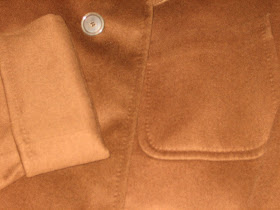
Edward Green's original specifications for the
Twickenham model,
commissioned by Paul Stuart in 1985.
I recently came across another pair of
Twickenhams in a dark brown calf leather but otherwise identical to the pair that I re-crafted at B. Nelson's earlier this year (see
here and
here). When I found them, the shoes were caked in a layer of dust and grime, and, in addition to some significant creasing, the leather was very dry.
On the other hand, while there was typical scuffing and scratching that one would expect to find on a pair of shoes in this condition, the leather didn't appear to be cracked anywhere - basically, there wasn't anything that a good cleaning and a leather conditioner bath wouldn't work wonders on.
The shoes are stamped for Lloyd Jennings, which to my understanding was a shoemaker of some distinction with premises on Old Bond Street - apparently comparable to John Lobb, but I have no firsthand knowledge of this (but would love to hear more if anyone has any additional information on the company).
The shoes also have the following handwritten information in each shoe: '"446/3" on one line, followed by "136470" on the second line," followed by "9.E" on the last line. The numbering is fading, so I'm not entirely sure if those numbers are accurate. But this shoe is clearly modeled on Edward Green's
Twickenham, which I have also seen referred to as the
Kingston model in Volume III of The World of High-End Men's Shoes by Men's Ex.
I've yet to see this model produced by any other English company, so while I'm not entirely sure, it would seem that these could very well be another pretty old pair of Edward Green shoes. Regardless of the provenance of the shoes, this particular pair appear to have been well-made.
The heels and the soles appear to be original and were in surprisingly good condition, considering how the uppers looked. I didn't think a resole/recraft was necessary in this case since I (1) already have a lovely pair of
Twickenhams in antique chestnut; and (2) these were just a bit snug on my feet (although a stretching would probably set this right).
So with that in mind, I decided to see just how much these might benefit from a basic cleaning with warm water, followed by a liberal application of Saphyr's Renovateur leather conditioner - I have become an avid Renovateur adherent, to the point where the conditioner is basically all I have been using on my shoes lately.
I began by cleaning the shoes with a brush to remove any particles that may have been lodged anywhere along the uppers. I then dampened an old cloth with room-temperature water, and wiped off as much of the dust, dirt, and stains as possible. I also used a toothbrush to try and clean between the uppers and the welt. Here are some photos with the left shoe still in soiled condition and after the right shoe had been cleaned/brushed/wiped:
A before-and-after contrast between the cleaned shoe versus the original condition. As you can see, the cleaned shoe already looks much better. There is still some scuffing to the shoe, and there is still substantive creasing. However, the Renovateur is applied with the express purpose of reducing the blemishes and creasing to the leather. Here's how the cleaned shoe looks after the Renovateur has been rubbed into the calf leather using a rag/cloth:
As you can see, the leather looks much better. While there is still evidence of some nicks and scratches, the overall tone of the shoe looks much healthier and vibrant. There is some darkness where the conditioner has sunk deeper into the leather via the creasing and scuffing, but I find that this discoloration generally disappears within 16-24 hours after application. Generally, the creasing will dissipate, to some extent, within 24 hours as well. Here are both shoes after cleaning and the application of the leather conditioner:
And finally, here are the shoes in natural light after another round of conditioner was applied 24 hours earlier:

Vintage Lloyd Jennings Saddle Shoes.
















































